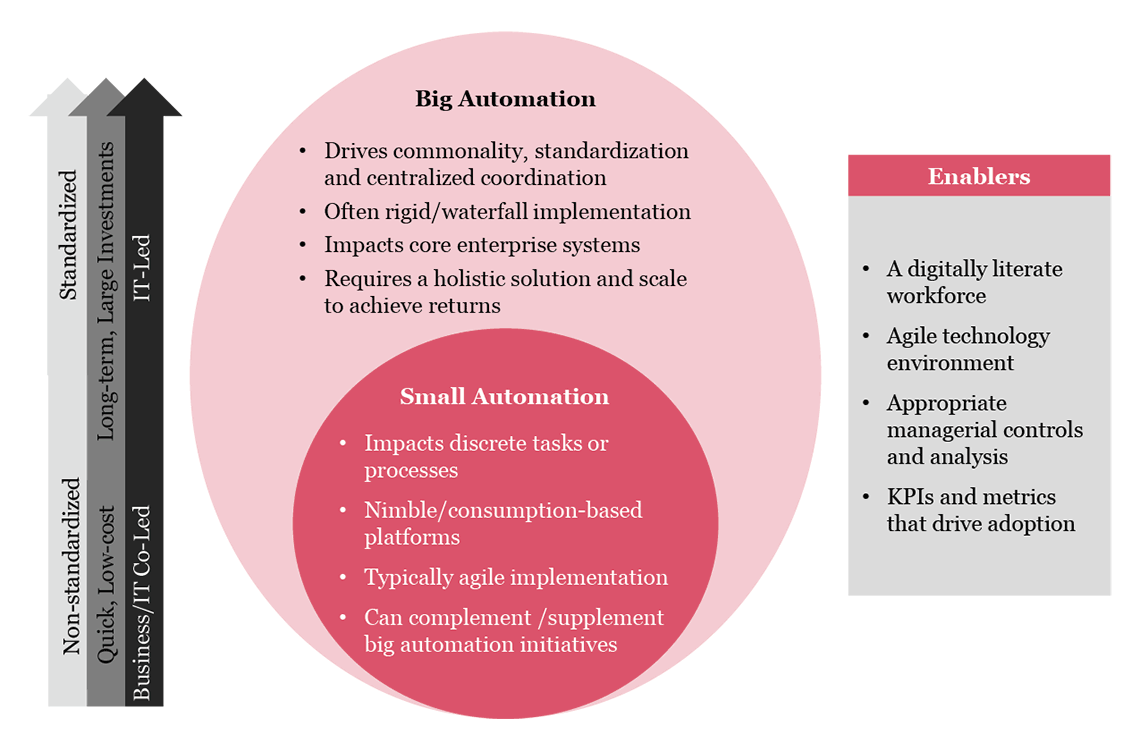Small automation, big benefits
January 10, 2019
Last year, strategy+business magazine laid out the basics of small automation and also defined three key tenets of the “small automation mindset”. These tenets were:
- Focus on value,
- Consider the future of work, and
- Take a big-picture view.
This post dives a little bit deeper into the first point and how the focus on value can drive significant results and return on investment. It will also take a deeper look at the trade offs between big and small automation.
Small automation, big benefits: A recap
Traditional technologies may be what first comes to mind when you think of automation - large projects to implement enterprise systems, ERPs and the like. This is what is called big automation - and along with it are big budgets and timelines. Small automation, on the other hand, can effectively operate at sub-scale. This includes technologies like RPA, machine learning and natural language processing. Based on research, small automation solutions, implemented quickly and cheaply, can improve “individual process productivity 80-100%.”1 This is a significantly higher return on investment than traditional big automation initiatives.
One case that illustrates the benefits of small automation comes from recent work at a consumer goods company. Automation solutions and results quickly followed from a diagnostic session with the client. The client was enabled to drive small automation efforts using a lean Center of Excellence approach combined with streamlined governance. In a matter of weeks, the COE was established and three RPA initiatives developed using IT developer resources. The cost was in the hundreds of thousands and savings are already on pace to exceed cost in the first year by two- to three-fold. The remaining pipeline of initiatives is estimated to drive large time savings and triple-digit returns on investment.
Contrast this to deploying a new ERP, or running an enterprise-wide master data management program that can span several years, use a large team, and cost tens of millions of dollars. Examples and experience prove that the results and returns often blow through initial timelines and fall short of expected value. When compared to the small automation scenario, it is easy to see why there has been so much demand in the market for small automation strategy and execution work.
The trade-offs?
The graphic below helps to visualize the trade-offs one would face when considering whether or not to pursue a small automation agenda. Recent experience shows that the trend is swinging towards the small automation end of the spectrum especially as the tools and methods to enable this become more powerful and robust1.
Small automation vs. big automation: What are my trade-offs?

From the graphic above, notice that one of characteristics of small automation is that it is well- suited to transform discrete tasks or processes. For example, a bot can be used to access financial systems and update budget sheets with actual spend numbers - saving time and eliminating low value added tasks. By automating mundane and repetitive tasks, workers can focus on higher value-add work and increase their overall work capacity.
Small automation is not only about saving time - it can also drive quality, consistency and service. Think, for example, about a predictive bot that assists Procurement Specialists in ensuring the best outcome for purchasing decisions. Using both RPA and machine learning the bot scans historical spend data and determines the best price, supplier, etc. for a commodity. The bot then presents the Procurement Specialist with the top-three recommendations. Even if your organization already has a large scale automation solution, flexible and adaptive “small” technologies can help fill in gaps and drive incremental productivity gains.
1The New Automation is Smart, Fast, and Small; strategy+business; April 24, 2018.
What are the enablers of small automation in my org?
Before you embark on your automation journey, big or small, consider whether you have one or more of these enablers in place:
- A workforce with sufficient Digital IQ - the technological acumen to experiment with new technologies (see PwC’s research on Digital IQ for an idea of where your industry stands).
- An IT ecosystem agile enough to support small automation solutions deployment, and the appropriate controls (and flexibility) in place.
- Performance metrics and employee evaluation criteria to support and reward productivity gains from small automation - building behavioral change requires the right supporting culture and management buy-in.
Where do I go from here?
Despite the natural anxiety around automation’s potential to eliminate jobs, robots are not coming for your job anytime soon. Evidence suggests that while the nature of work may shift-towards higher-skilled roles, workers themselves are not becoming obsolete. Consider that artificial intelligence and automation are enablers - not be-all, end-all solutions.
This post explored in further detail the benefits and tradeoffs of small vs big automation. It also proposed a framework to assess which approach (big vs. small) is right for your enterprise or your situation. Subsequent posts will explore the remaining tenets of small automation and work to establish a case for how it can be a key lever to unlock value in your organization.
Contact us







